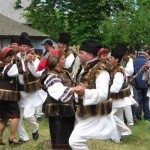On February 24, the day when the Orthodox Christian church celebrates The Finding of St. John the Baptist's Head, the Romanian folklore celebrates the day called Dragobete. Dragobete was the god of love in the Romanian pantheon, protector of love and good spirits.Dragobete, the God of love and cheerfulness in Romania, called also the Hedad of spring or the Head of summer, is the son of Dochia. He is identified with Cupid, the god of love in Roman mithology, and with Eros, the god of love from the Greek mithology. Locally, he is called the Hothead, handsome young man, who makes girls and young women get infatuated with him. He was transformed by the Virgin Mary into the flower called Heart’s tongue (Phyllitis scolopendrium). Dragobete was celebrated by the young people from the villages until the mid 20th century on February 24 and 28 or on March 1 and 25.
In Romania, Dragobete was the day when the girls and boys put on their best clothes and, if the weather was good, they used to go out in the forest singing and looking for the first spring flowers. The girls used to gather snowdrops, violets, and other spring flowers, which they used to put near the religious icons and saved them till the holiday called Sanziene (Bedstraw, on Midsummer Day), when they threw them in the rivers. If they happened to find wild strawberry flowers (Fragaria vesca), these flowers were gathered in small bouquets and they were put in the girls’ washing water whille they chanted:” Wild flowers of strawberry / Picked on February/ Let all people love me/ Send bad things away from me”.On the Dragobete morning, the girls and young women used to gather the fresh snow, melt it and use it to wash their face and hair, believing that people would like better their face and hair.
Romanian version:La 24 februarie, in ziua cand ortodoxia sarbatoreste Aflarea capului Sf. Ioan Botezatorul, spiritualitatea populara consemneaza ziua lui Dragobete, zeu al tineretii in Panteonul autohton, patron al dragostei si al bunei dispozitii.Zeul dragostei si bunei dispozitii pe plaiurile carpatice, numit si Cap de Primavara sau Cap de Vara, este Dragobete, fiul Dochiei. El este identificat cu Cupidon, zeul dragostei in mitologia romana, si cu Eros, zeul iubirii in mitologia greaca. Local, este numit Navalnicul, fecior frumos care ia mintile fetelor si nevestelor tinere, metamorfozat de Maica Domnului in floarea cu acelasi nume. Dragobetele a fost sarbatorit de tinerii satelor pana la mijlocul secolului al XX-lea la 24 si 28 februarie sau la 1 si 25 martie. In ziua de Dragobete pasarile nemigratoare se strang in stoluri, ciripesc, se imperecheaza si incep sa-si construiasca cuiburile.La noi, Dragobete era ziua cand fetele si baietii se imbracau in haine de sarbatoare si, daca timpul era frumos, porneau in grupuri prin lunci si paduri, cantand si cautand primele flori de primavara. Fetele strangeau in aceasta zi ghiocei, viorele si tamaioase, pe care le puneau la icoane, pentru a le pastra pana la Sanziene, cand le aruncau in apele curgatoare. Daca, intamplator, se nimerea sa gaseasca si fragi infloriti, florile acestora erau adunate in buchete ce se puneau, mai apoi, in lautoarea fetelor, in timp ce se rosteau cuvintele: "Floride fraga/Din luna lui Faur/La toata lumea sa fiu draga / Uraciunile sa le desparti". In dimineata zilei de Dragobete fetele si femeile tinere strangeau zapada proaspata, o topeau si se spalau cu apa astfel obtinuta pe cap, crezand ca vor avea parul si tenul placute admiratorilor.
Bibliography:
http://en.wikipedia.org/wiki/Dragobete
http://www.e-transport.ro/DRAGOBETE_OBICEIURI_DE_DRAGOBETE_ZIUA_INDRAGOSTI-i41-news25867-p82.html
Bibliography:
http://en.wikipedia.org/wiki/Dragobete
http://www.e-transport.ro/DRAGOBETE_OBICEIURI_DE_DRAGOBETE_ZIUA_INDRAGOSTI-i41-news25867-p82.html






Daniela was you doing so great... pleasure i am having you and proud of you
ReplyDelete